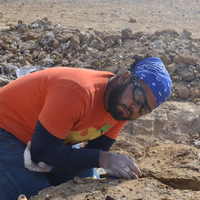Belal Salem
Benha University, Geology, Faculty Member
Numerous non-avian theropod dinosaur fossils have been reported from the Upper Cretaceous (Cenomanian) Bahariya Formation, Bahariya Oasis, Western Desert of Egypt, but unambiguous materials of Abelisauridae have yet to be documented. Here... more
Numerous non-avian theropod dinosaur fossils have been reported from the Upper Cretaceous (Cenomanian) Bahariya Formation, Bahariya Oasis, Western Desert of Egypt, but unambiguous materials of Abelisauridae have yet to be documented. Here we report Mansoura University Vertebrate Paleontology Center (MUVP) specimen 477, an isolated, well-preserved tenth cervical vertebra of a medium-sized abelisaurid from the Bahariya Formation. The new vertebra shows affinities with those of other Upper Cretaceous abelisaurids from Madagascar and South America, such as Majungasaurus crenatissimus , Carnotaurus sastrei , Viavenator exxoni and a generically indeterminate Patagonian specimen (Museo Padre Molina specimen 99). Phylogenetic analysis recovers the Bahariya form within Abelisauridae, either in a polytomy of all included abelisaurids (strict consensus tree) or as an early branching member of the otherwise South American clade Brachyrostra (50% majority rule consensus tree). MUVP 477, therefor...
Research Interests:
Abstract Upper Cretaceous dinosaur remains from Afro-Arabia are rare and mainly restricted to pre-Turonian horizons. Consequently, the discovery of new fossils from Upper Cretaceous deposits in the Western Desert, central Egypt is... more
Abstract Upper Cretaceous dinosaur remains from Afro-Arabia are rare and mainly restricted to pre-Turonian horizons. Consequently, the discovery of new fossils from Upper Cretaceous deposits in the Western Desert, central Egypt is significant because it adds to the meager record of dinosaurs described from this landmass. The oases of Kharga and Dakhla, Western Desert, Egypt, expose the Quseir Formation (Campanian), with the titanosaurian sauropod Mansourasaurus shahinae as the only currently named dinosaur from strata of this age in the entire region. Numerous (~80) other non-avian dinosaur fossils have also been collected from the Quseir Formation, including material that can be referred to Somphospondyli, Titanosauriformes/Titanosauria, and non-avian Theropoda. Among the discoveries from the Dakhla Oasis are the proximal ends of an associated sauropod tibia and fibula and several sauropod caudal vertebrae representing both sub-adult and adult individuals. Middle caudal vertebrae can be referred to Titanosauria on the basis of procoelous centra and anteriorly displaced neural arches. One caudal vertebra even exhibits pneumatic internal structures rarely observed outside of the Upper Cretaceous South American saltasaurines. Dinosaur fossils recovered from the Kharga Oasis include a partial femur and partial cervical vertebra of a sauropod dinosaur and an isolated proximal fibula of a non-avian theropod dinosaur. Taken together, these findings indicate that Late Cretaceous North African ecosystems supported a diversity of non-avian dinosaurs, some demonstrating affinities with South American forms and others (e.g., Mansourasaurus) with Eurasian groups. Additional exploration of the uppermost Cretaceous units in southern Egypt offers promise for the discovery of important fossils to better characterize Afro-Arabian biotas generally while also providing important perspectives on non-avian dinosaur faunas near the close of the Mesozoic Era.
